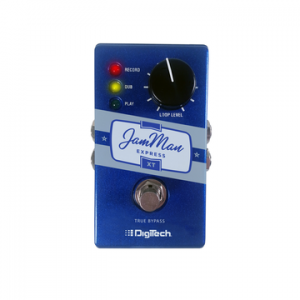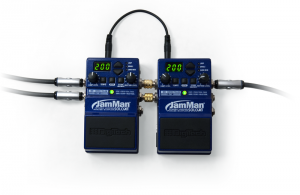
The Digitech Jamman XT Express: Synced Loop Firepower, Cheap
Digitech has just announced a new looper, the Jamman XT Express. I haven’t seen or touched one yet, so I don’t know how it performs in action. However, the feature set is both stripped down and immensely powerful for the price, provided you already own a Digitech Jamman Solo XT.

While The XT Express can be used as a standalone looper, it is so obviously conceived as a companion to the Solo XT that it’s appropriate to discuss them together. The XT Express’s feature set is minimal in variety, but each of the few features contains exactly the right stuff for adding independent layers to a JamMan Solo XT. The XT Express will only record one loop at a time–the next loop you record replaces the previous one–and there are only ten minutes available for the loop. That’s too bare-bones minimum in both dimensions for my taste, but when you consider that you can use the XT Express to add an independent loop layer to a loop running on a Solo XT, that’s a lot of power for an extra $100. (Note that with an FSX3 footswitch, a JamMan Solo or JamMan Stereo allows the player to erase/re-add the most recently added loop layer, which is in effect an independent track.)
There’s no USB connection on the XT Express, so no way to offload a loop except by playing it and recording the audio into another looper or recording device. Other things the XT Express lacks include the ability to mix inputs from a mic and a stereo line input at the same time (which the Solo XT also lacks, though the JamMan Stereo has it–I guess there’s no room for a mic preamp in the Solo XT form factor); the ability to play back multiple prerecorded loops in a predefined sequence via footswitches; the ability two linked Solo XTs have to play independent loops where the length of one is multiple lengths of the other (so you might have a 2-bar drum loop with an 8-bar bassline, for example). You can’t do any of that with the XT Express. The only things you can do with the XT Express are record up to ten linear minutes of high-quality audio (24-bit 44.1 kHz, plenty good for a floor looper), loop it, set the volume level of the loop playback, and sync the loop to a loop running on another XT Express or a Solo XT. This thing is designed for one-shot performance, it seems, which is fine for $99, and super-fine when you have a Solo XT in the picture to fill in all the gaps.

Anyone who wants maximum looping power for $200, plus the option to sync with other Digitech XT loopers, is well advised to buy a JamMan Solo XT instead of two XT Expresses. In effect, the Solo XT gives you two independent loops anyway (when you add an FSX3 footswitch for another $35, which is well worth it). But a JamMan Solo XT paired with an XT Express gives you the equivalent of three independent synced loop tracks–two on the Solo XT, and one on the XT Express–at a total cost of $300, which is a good $100 cheaper at least than you can get the same track count from anyone else. (The alternatives generally come with much larger form factors, too, which gives you a tradeoff between portability and playability to consider.) You can use the Solo XT to carry and manage your prerecorded loops, if any, and route audio signals through the XT Express to the Solo XT to maintain track independence. (If you routed audio the other way, prerecorded tracks would be mixed with new material on the XT Express.)
A big question to me is how well sync (“JamSync”) between these devices actually works in practice. My hope is that it’s fast (meaning they sync instantly) and reliable (meaning no false starts or drop outs). If JamSync doesn’t work well, then these devices are worth a lot less than the asking price. I’ll test one each of these devices sometime in August 2013, when the XT Express becomes available, and we’ll see how JamSync works. Stay tuned.
Related Posts
3 Comments
Leave a Reply
You must be logged in to post a comment.
WHAT’S NEW
Categories
- Audio/Video
- Blog
- Blue Future
- Digitech RP Tricks and Tips
- Discography, CDs, Projects, Info, Notes
- Featured Video
- For the Beginner
- Gallery
- Hunter's Effects
- Hunter's Music
- Huntersounds for Fender Mustang
- Meet the Pros
- More Video
- MPH: Maw/Preston/Hunter
- My Three Big Contributions
- Player's Resources
- Pro Tips & Techniques
- Recommended Artists & Recordings
- Recommended Gear
- Recorded Performances
- Reviews, Interviews, Testimonials
- The Lucky One
- Uncategorized
- Upcoming Performances
- Zoom G3 Tips and Tricks
I haven’t tried this parcicular JamMan model yet but personally, I chose the Boss RC-3 when I was in the market for a looper but I’ve also used my friend’s Ditto looper and it’s AWESOME at what it does. My looper has drastically improved my skills – I highly recommend them.
I scoured Amazon’s best seller list and really weighed the features as well as the pros and cons before plunking my cash down and deciding for myself.
http://amzn.to/16K5DXl
Whether it’s the Ditto, Boss, or DigiTech…they’re all solid loopers it’s all about what you need and what you do with them. Cheers!
Yes, it’s a wonderful practice and composition tool. And they’re getting less expensive all the time.
I bought a Solo XT & Express XT. I explored the basics and the JamSync & then seriously
began to work through the Solo XT operation.
Brick wall: The first time through the click-track OK. Make a change and click-track disappears. How am I supposed to record without timing?
Rule one: Buy and use a metronome before you buy a looper.
(The next dumb-a*** sales assistant that says “yes, it has a clikk-track . .”)
I also recorded the click-track of the Solo to the Express and then recorded to the Solo,
using the click-track playing on the Express. This clumsy method results in a recorded
track on the Solo with its own click-track to match.
Right, now let’s get serious. The idea of setting Tempo by pressing a button.
THIS IS BULLDUST ! Can you tap in a tempo of 128 BPM correctly, everytime?
Can you change it to 130 BPM correctly everytime just by tapping?
If you can, how do you know? The Solo won’t tell you.
I figure a PIC connected to the FXs-3 can digitally set accurate tempe.
So when ever you read “just tap in the tempo . .” SNAKE OIL!
Cheers Terry